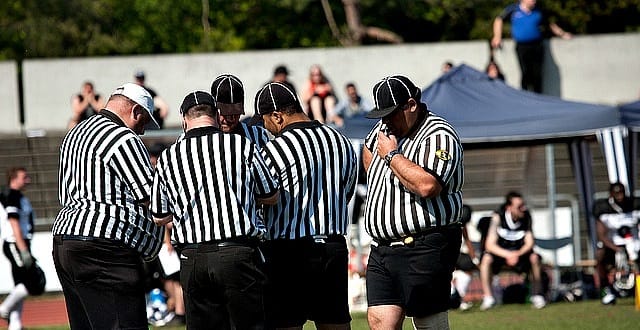First and Tendencies

For the last year or so, I’ve been attempting to teach my girlfriend the rules of football. Having had her interest piqued in the beauty and grandeur of grown men colliding at high speeds, she’s made a valiant attempt at learning the intricacies of my favorite sport.
Teaching someone the rules of football is always a difficult proposition. But it was curious to watch her befuddlement at things that seemed so “natural” to me. I grew up in a football family. My brother was a halfback at North Carolina. Football always made sense, even in its nonsensical moments. Having to explain the grey areas of the game—what constitutes possession, forward progress, pass interference—cemented something that should be clear to gridiron fans, but isn’t.
Football is really complicated.
Football is complex the way that surgery is complex or learning Arabic is difficult. I’d heard someone once say that programmers don’t fall in love with syntax; they fall in love with making things. The same could be said for football—nobody relishes the enforcement of arcane rules. And yet football is a game filled with beautiful nuance; and nobody knows that negotiation better than Rogers Redding, a former teacher of molecular physics and the national coordinator for officiating NCAA football—ensuring a consistent application of playing rules and refereed mechanics. What follows are excerpts of my hourlong talk with the arch-rulesman. What I hope emerges is a love letter to the nature of rules. What else are games but the enactment, pursuit, and passion of boundaries and their inherent joys and disappointments?
On Learning to Be a Referee
It should not be surprising that refereeing is an unusual calling. Sucking a sport dry of all its excitement to focus on a single zone or player requires an unusual, perhaps sadistic, disposition. While the rest of the world watches the ball and the magic of athleticism, refs are focused on the minutiae and bound to the rulebook:
“The tendency is to follow the ball, and that’s the first mistake.”
One of the things we teach officials is, there’s lots of stuff going on that has nothing to do with the football. So, watching the game from the standpoint of a referee—for example, the whitehead referee who stands behind the quarterback; he’s got to keep his eyes on the quarterback and really not follow the ball, which is hard. Watching the game as a fan versus watching it as an official, you look for different things.
You watch not the quality of the play and not the excitement of the game, but the way it’s managed and the way it’s administered by the officials. Every officiating position on the field has particular “keys”; that is, particular players they’re supposed to watch, particular zones of the field they’re supposed to watch. There are a lot of habits that have to be broken, and other habits learned, when you’re becoming an official. Especially for a person who has played the game or watched the game a lot as a fan, the tendency is to follow the ball, and that’s the first mistake.
The other most common mistake, even for very senior officials, is breaking concentration. [Football] is very fast, and if you lose concentration even for a fraction of a second, that’s when something’s going to happen that gets by you that was critical to the game.
On Balance
Fans of fighting videogames like Street Fighter will notice the time and effort spent “tuning” characters to make sure that the game is balanced. This is a constant complaint from edition to edition in the series, as old favorites are weakened in favor of a better, more balanced endgame.
Consider the work of David Sirlin, lead designer on Super Street Fighter II Turbo HD Remix, who was tasked with making the game more fair. In a section on Ryu, arguably the “Mickey Mouse” figure of the series, he encountered a problem:
In ST, projectiles like fireballs are extremely powerful, and that’s part of what makes positioning and spacing so important. Strong projectiles add depth to the game. The problem is that in ST, fireballs are just a little too strong. One of my goals with SF HD Remix is to reduce the number of really bad matchups—matches where one character dominates the other—and that list from ST is full of matches where a projectile character dominates a non-projectile character.
Sirlin’s entire existence is devoted to balance, and so is Redding’s. One recent realization, from a lifelong football fan, was that in football, the defense is always at a disadvantage (this is not always the case in actual warfare—see Russia, for example). Consider the defense to be “non-projectile” characters who simply have to wait. There are two handicapping realities of running a football defense: the offense knows the plays, and the offense knows the snap count (i.e., when the play will start). Redding and his committee often advocate to protect the defense—which, to me, contradicts its reputation for being reckless and rogue:
A few years ago, when the games were beginning to run long, in the order of three-and-a-half hours, television didn’t like that, because it was going too long and they had other programming scheduled.
The rules were changed to have the clock started more frequently than it was at the time. That quickened the game, but it reduced the number of plays so much that the offensive coaches were just howling. The number of plays was being reduced significantly, so [offense] weren’t able to get all their plays in. It was almost a firestorm.
The committee came back and made some changes. What they ultimately settled on was a set of rules about the clock that maintained the number of plays that the offense wanted, but also shaved about 12 to 15 minutes off the total length of the game. That’s an example of the back-and-forth between the offense and the defense around what the rules should be, and that competitive balance.
On Nuance
Try explaining possession to someone who’s never watched football. (For those who haven’t, possession simply means having control of the ball.) What constitutes a catch and what doesn’t requires a flexible definition of reality, shaped by what a player’s intent is when he receives the ball, and how he manages to keep the ball once he already has it. Look at New York Giants receiver David Tyree’s 2009 Super Bowl catch, a play so famous that it has its own Wikipedia entry, to see how blurry the line can be.
This is one arena where football and live sports differ from games. Videogames allow for no such opaqueness—either something happened, or it didn’t. But for anyone who’s ever been cheated by a CPU (I’m looking at you, NBA Jam), that uncertainty at least exists in our minds as players:
That’s one of the reasons the officials train so much, because it’s their judgment that matters there. In other words, it’s the judgment of the referee: Was the quarterback under pressure or not? The quarterback feels like he’s always under pressure. The defense feels like, “heck, he’s not under pressure; we don’t have him in our grasp,” so the official has to sort of make a distinction between those two. That’s why we use so much video [to make calls].
Videogames allow for no such opaqueness—either something happened, or it didn’t.
You mentioned “possessing the ball”—talking about when the catch is completed, whether or not the player has control of it when he falls out of bounds, or he comes to the ground and the ball comes out; that kind of thing. That’s why instant replay has impacted as well. The fact that we can now look at a play from 19 angles and slow it down to super-super-slow-mo, and see almost nanosecond by nanosecond what’s happening: that’s why the use of video has revolutionized how officials train.
One of my jobs is to create the video that officials study in order to have a better sense of what they’re looking for when they’re on the field. Now on the field it happens in realtime, of course, at a very live speed, so they don’t have the luxury of stopping the game and watching the video. That’s why the officials in the Super Bowl, the officials in the National Championship game, are always the best, because they’ve worked so long and they have so much experience and judgment.
A fan sees this, and they say, “That ought to be easy to call,” and then many times at clinics and workshops we’ll take the press down on the field and have them work a position. And they’ll say, “Man, this is a lot different than I thought it was going to be.” It looks a lot different from [the field] than it does in the press box, because you have to watch for those things. You develop a muscle memory about what to look for and what your instincts are in terms of possession, and were his feet in bounds or not.
On Ethics
I pointed Redding to the moral philosophy of communitarianism, which seeks to build connections between individuals and community. The rules of football, like those of many sports, are fungible, the product of generations of play and representing something akin to a democratic sense of fairness. This, of course, creates problems and disagreements—but Redding was interested in pursuing the job of the rules chairman as a negotiator. Ecologist Marc Bekoff has described play as “training for the unexpected”—people like Redding make sure the rules are in place to judge when that unknown event happens.
That idea, of identifying a common good through games, is something all of us do. It’s considered poor form (or in some cases an instant disqualification) to press Pause during fighting games or peek at the map during a multiplayer GoldenEye 007 match: these are examples of the myriad ways we as players create our own systems of fairness.
There are cultural [aspects of] baseball that are communitarian in nature. When a runner steals a base, and the catcher tries to throw him out at second base; if the ball gets there first, he’s going to be out, whether the tag actually happens or not.
I like the term “communitarian.” The community has subtly agreed, “We’re going to play it that way, even though technically the rule says he’s not out.” There’s a lot of that in football. For example, let’s say the offensive tackle has a bear hug on the defensive tackle across from him, but the play is 40 yards away. You’re not going to call that because it has no impact on the play. But the same action at the “point of attack”—where the ball carrier is—that would have been a foul. The community has agreed, “Yeah, that’s OK, we’ll let that go,” even though the rulebook clearly says foul.
“If the officials called the game exactly […] as the rulebook is written, there’d be fouls every play and you’d never get out of there, and it would make a travesty of the game.”
Another example of that is […] what’s going to be called as pass interference. There’s a lot of hands feeling and little mutual tugging and shoving—not big-time stuff, but subtle little things that, if the officials called the game exactly point-by-point, comma-by-comma as the rulebook is written, there’d be fouls every play and you’d never get out of there, and it would make a travesty of the game.
Some of the fans’ frustration is, just to put it bluntly, that the fans are not part of that community. They’re not in on the inside stuff, so to speak. That’s not bad or good, it just is what it is. I completely understand that frustration. I get a lot of emails from angry fans about games and why this doesn’t happen and why that doesn’t happen. It’s just part of the community and internal agreements about how the game is going to be played.
Thanks to Eric Zimmerman and NYU for bringing Redding to my attention. This interview has been edited for length and clarity.
Photograph by Yago Veith



